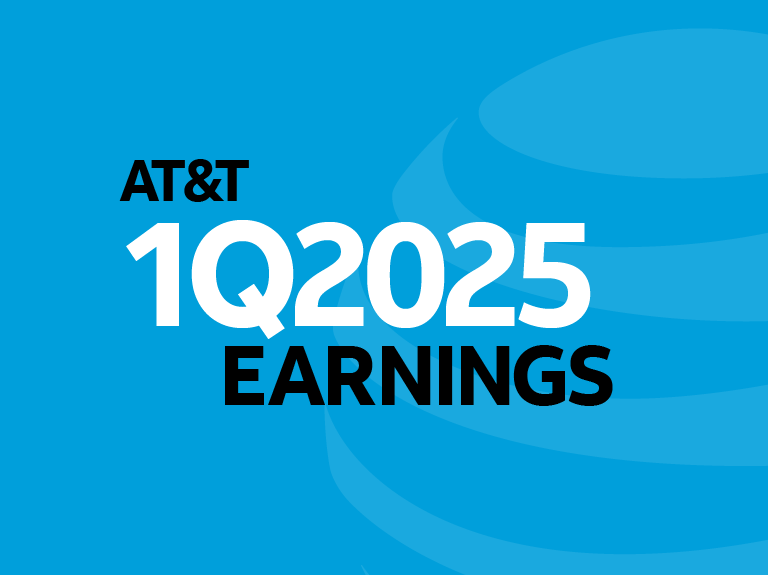AT&T Announces Q2 Earnings
AT&T Reports Second-Quarter Results
Strong cash flows reflect resiliency of core subscription businesses; balance sheet strengthened; business transformation underway
- Diluted EPS of $0.17 as reported compared to $0.51 in the year-ago quarter
- Adjusted EPS of $0.83 compared to $0.89 in the year-ago quarter (did not adjust for COVID-19 impacts: ($0.03) of incremental costs and ($0.06) of estimated revenues)
- Cash from operations of $12.1 billion
- Capital expenditures of $4.5 billion; purchased additional $1 billion in new spectrum for 5G
- Free cash flow of $7.6 billion; total dividend payout ratio of 49%1
- Consolidated revenues of $41.0 billion
Note: AT&T's second-quarter earnings conference call will be webcast at 8:30 a.m. ET on Thursday, July 23, 2020. The webcast and related materials will be available on AT&T’s Investor Relations website at https://investors.att.com.
AT&T Inc. (NYSE:T) reported second-quarter results that continue to underscore the financial strength and ample liquidity of the business even with current economic conditions.
Second-Quarter Highlights
Communications
- Mobility:
- Service revenues down 1.1% due to decline in international roaming; equipment revenues up year over year
- Postpaid phone churn of 0.84%, a 2-basis point improvement year over year and postpaid phone2 net losses of 151,000 (Note: these include 338,000 accrued disconnects for which the company continues to provide service for Keep America Connected programs)
- Total phones stable (both postpaid and prepaid)
- 135,000 prepaid phone net adds2; lowest prepaid churn ever
- Named nation’s best and, for the 6th consecutive quarter in a row, the fastest network in the nation3
- Service revenues down 1.1% due to decline in international roaming; equipment revenues up year over year
- Entertainment Group:
- Solid video and IP broadband ARPU gains
- AT&T TV gains help offset video losses; video subscribers impacted by COVID-19 and marketing focus on high-value customer base:
- 17.7 million premium TV subscribers – 886,000 net loss; 91,000 attributed to Keep America Connected programs
- 225,000 AT&T Fiber net adds
WarnerMedia
- Successful launch of HBO Max with strong engagement
- COVID-19 impacts revenue and expenses
“Our solid execution and focus in a challenging environment delivered significant progress in the quarter, most notably the successful launch of HBO Max, resilient free cash flow and a strengthened balance sheet,” said John Stankey, AT&T chief executive officer. “Our resilient cash from operations continues to support investments in growth areas, dividend payments and debt retirement. We are aggressively working opportunities to sharpen our focus, transform our operations and continue investing in growth areas, with the customer at the center of everything we do.”
Consolidated Financial Results
AT&T's consolidated revenues for the second quarter totaled $41.0 billion versus $45.0 billion in the year-ago quarter. The COVID-19 pandemic impacted revenues across all segments. Declines at WarnerMedia included lower content and advertising revenues partly due to COVID-19. Revenues also declined in domestic video and legacy wireline services, and Latin America was impacted by foreign exchange pressure.
Operating expenses were $37.4 billion versus $37.5 billion in the year-ago quarter, essentially flat. Lower WarnerMedia costs, primarily associated with lower revenues, lower Entertainment Group costs and lower Latin America costs were offset by a goodwill impairment at Vrio, severance charges and incremental COVID-19 costs.
Operating income was $3.5 billion versus $7.5 billion in the year-ago quarter, due to the Vrio goodwill impairment, severance charges, COVID-19 costs and the net impact of lower revenues and operating expenses. Operating income margin was 8.6% versus 16.7% in the year-ago quarter. When adjusted for the non-cash Vrio goodwill impairment, amortization, severance charges, merger- and integration-related expenses and other items, operating income was $9.0 billion versus $9.9 billion in the year-ago quarter, and operating income margin was 21.9% versus 22.0% in the year-ago quarter.
Second-quarter net income attributable to common stock was $1.2 billion, or $0.17 per diluted common share, versus $3.7 billion, or $0.51 per diluted common share, in the year-ago quarter.
Adjusting for $0.66, which includes the non-cash Vrio goodwill impairment, merger-amortization costs, severance charges, merger- and integration-related expenses and other items, earnings per diluted common share was $0.83 compared to an adjusted $0.89 in the year-ago quarter. The company did not adjust for ($0.03) of incremental cost and ($0.06) of estimated revenue impacts from COVID-19.
Cash from operating activities was $12.1 billion, and capital expenditures were $4.5 billion. Capital investment – which consists of capital expenditures plus cash payments for vendor financing – totaled $5.0 billion, which included about $560 million of cash payments for vendor financing. Free cash flow – cash from operating activities minus capital expenditures – was $7.6 billion for the quarter. The company also invested $1 billion to acquire 5G spectrum. Net Debt declined by $2.3 billion sequentially in the quarter and net-debt-to-adjusted EBITDA at the end of the second quarter was about 2.6x4.
Guidance
Due to the continued lack of visibility related to COVID-19 and its economic impact, the Company is providing limited financial guidance. The Company continues to expect the total dividend payout ratio at yearend 2020 to be in the 60s% range1 and is targeting the low end of that range. The Company also expects gross capital investment in the $20 billion range5 in 2020.
1Free cash flow dividend payout ratio is total dividends paid divided by free cash flow
2All subscriber counts exclude customers who we have agreed not to terminate service under the FCC’s “Keep Americans Connected Pledge”. For reporting purposes, the company counts these subscribers as if they had disconnected service.
3America’s Best Network based on GWS OneScore Sept. 2019; Fastest based on analysis by Ookla® of Speedtest Intelligence® data of average download speeds for Q1, Q2, Q3, Q4 2019, and median download speeds for Q1 and Q2 2020. Ookla trademarks used under license and reprinted with permission.
4Net Debt to adjusted EBITDA ratios are non-GAAP financial measures that are frequently used by investors and credit rating agencies to provide relevant and useful information. Our Net Debt to Adjusted EBITDA ratio is calculated by dividing the Net Debt by the sum of the most recent four quarters of Adjusted EBITDA.
5Gross capital investment includes capital expenditures and cash payments for vendor financing and excludes expected FirstNet reimbursements; in 2020, vendor financing is expected to be about in the $3 billion range and FirstNet reimbursements are expected to be about $1 billion.



